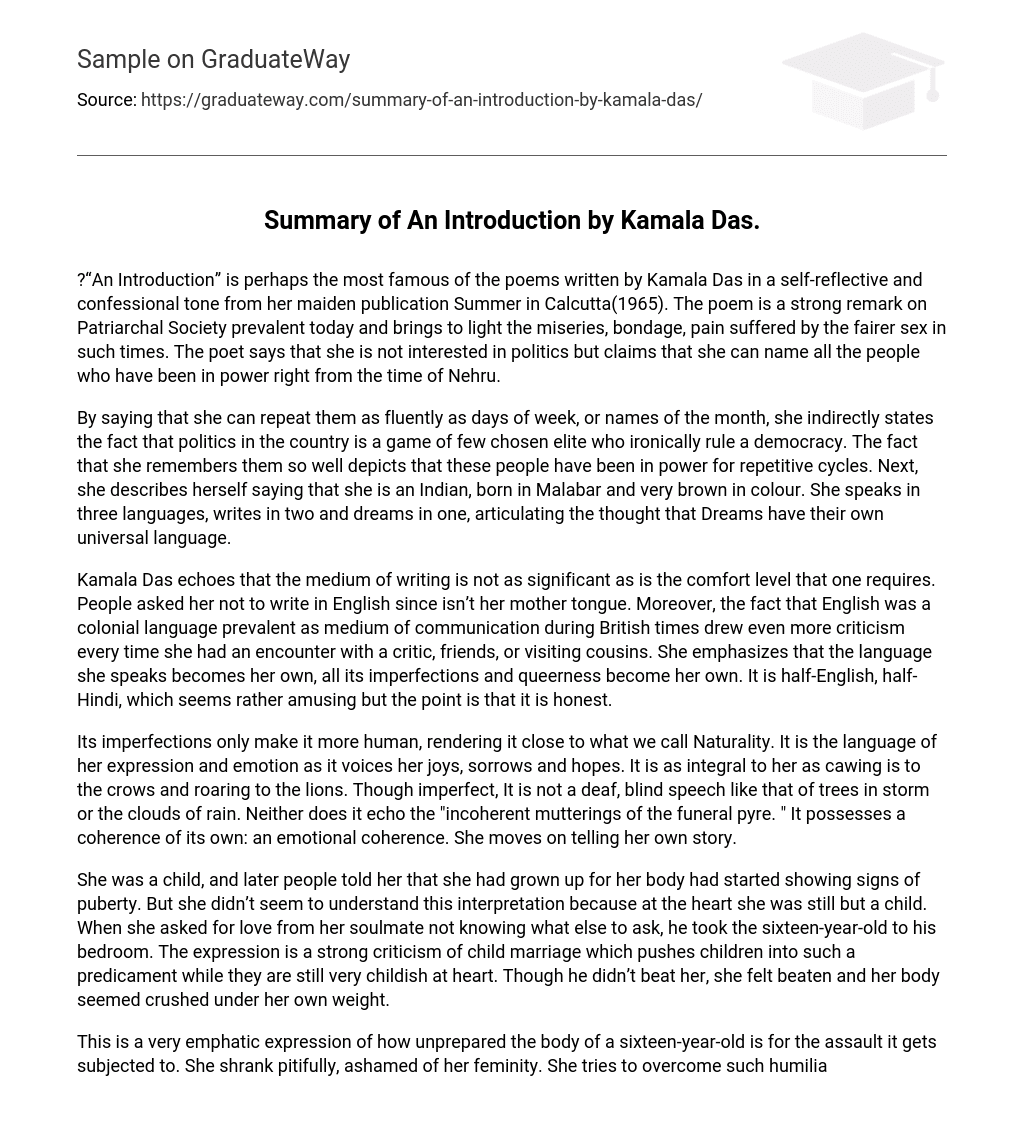“An Introduction” by Kamala Das is a renowned poem from her first book, Summer in Calcutta (1965), that serves as a powerful critique of the patriarchal society still prevalent today. With a reflective and confessional tone, the poem enlightens us about the hardships and oppression faced by women. Although the poet disclaims any political inclination, she boldly proclaims her capability to recognize every person who has held authority since Nehru’s era.
The author indirectly suggests that politics in the country is controlled by a privileged few who ironically govern a democracy, by stating that she can repeat their names as easily as she can recall the days of the week or the months of the year. The author’s excellent recollection suggests that these individuals have held power for multiple terms. Additionally, the author describes herself as an Indian, specifically hailing from Malabar, with a brown complexion. She communicates in three languages, writes in two, and dreams in one, emphasizing the notion that dreams possess a universal language of their own.
Kamala Das believes that the significance lies not in the medium of writing, but in the level of comfort one needs. Even though she was advised against writing in English, as it is not her native language, she faced criticism whenever she encountered critics, friends, or visiting cousins because English was a colonial language used during British times. She emphasizes that the language she speaks becomes her own with all its flaws and peculiarities. Her language is a mixture of half-English and half-Hindi, which might be seen as amusing, but the crucial aspect is its authenticity.
Naturality is the language of expression and emotion. It is imperfect, making it more human, like cawing for crows or roaring for lions. It is a crucial part of her being, allowing her to express her joys, sorrows, and hopes. Unlike trees in a storm or rain clouds that cannot speak or see, Naturality has its own emotional coherence. It is not the incoherent mutterings of a funeral pyre. She remains steadfast in telling her own story.
Despite being informed of her physical maturation, she continued to perceive herself as a child deep down. In a state of confusion and longing for affection, she sought solace in her soulmate, who guided the sixteen-year-old girl to his bedroom. This instance serves as a poignant condemnation of child marriage, thrusting minors into adult circumstances while their innocence remains intact. Though no physical harm befell the young girl, she endured emotional distress and was engulfed by her own burdens.
This passage strongly conveys the vulnerability experienced by a sixteen-year-old’s body and the unpreparedness it faces when subjected to assault. Overwhelmed with shame for her femininity, she timidly retreats, attempting to regain control by embracing tomboyish behavior. However, her efforts to conceal her femininity through male clothing are met with resistance from authority figures who enforce traditional female attire. They warn her to conform to society’s expectations of womanhood, which include becoming a wife and mother and being confined to domestic responsibilities. She is threatened with confinement to the limited space deemed appropriate for females, out of fear that she may develop psychic or erratic behaviors.
They even ask her to hold her tears when rejected in love. She refers to them as categorizers because they have a tendency to categorize every person based on arbitrary criteria. She recounts her experience with a man and describes him not by his name, but by a general term – “every man” – to emphasize his universal nature in a patriarchal society where such characteristics are inherent in all males simply due to their gender. He defines himself through his ego and is metaphorically depicted as a “sword in its sheath”, symbolizing his tightly compartmentalized nature.
The excerpt highlights the power dynamics within our patriarchal society that revolves around control. It emphasizes how the freedom of this individual (“I”) knows no bounds, freely laughing at his own discretion. This individual succumbs to the desires of a woman purely driven by lust, but later feels ashamed of his own vulnerability to her. Towards the end of the poem, a shift takes place as the “I” gradually transitions to the poetess herself. She acknowledges how this “I” embodies both sin and virtue, experiencing both love and betrayal. Through this role-reversal, the woman emerges as the new “I,” asserting her own identity.





